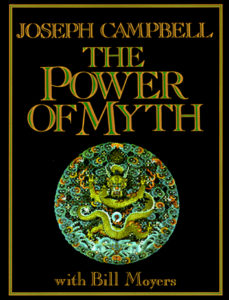I took on The Power of Myth during my final week in GigCity. I had learned to surf, purchased a car, and seen most of what I wanted to in Dunedin and Mosgiel. I found out that I couldn’t put it down once I started reading it. The recommendation actually came from my therapist Jacob Spilman. During my 5th or 6th session with him, towards the end of February 2018, he recommended this book. He had actually recommended two books to me, one of which I read before coming to New Zealand – The Hero with a Thousand Faces. While both are great books and representative of the scholarship of Joseph Campbell, if I had to recommend only one, it would be The Power of Myth.
Recommendation #4 from Jacob Spilman
The Power of Myth by Joseph Campbell
From Wikipedia – The Power of Myth is a book based on the 1988 PBS documentary Joseph Campbell and the Power of Myth. The documentary was originally broadcast as six one-hour conversations between mythologist Joseph Campbell (1904–1987) and journalist Bill Moyers. It remains one of the most popular series in the history of American public television.
I’ve gotten into the habit of photographing pages of books if I want to remember something that impacted me. I actually took 16 photographs while reading this book, which speaks to how much it has influenced me and my thinking. And to find out that it is one of the most popular series in the history of American public television just confirms even more why it deserves to be on this list of recommendations.
Here are just a few quotes that I found stimulating…
 “Certain prayers or meditations are designed to hold your consciousness on that level instead of letting it drop down here all the way. And then what you can finally do is recognize that this is simply a lower level of that higher consciousness. The mystery that is expressed there is operating in the field of your money, for example. All money is congealed energy. I think that’s the clue to how to transform your consciousness.”
“Certain prayers or meditations are designed to hold your consciousness on that level instead of letting it drop down here all the way. And then what you can finally do is recognize that this is simply a lower level of that higher consciousness. The mystery that is expressed there is operating in the field of your money, for example. All money is congealed energy. I think that’s the clue to how to transform your consciousness.”
“Where is your bliss station? You have to try and find it. Get a phonograph and put on the music that you really love, even if it’s corny music that nobody else respects. Or get the book you like to read. In your sacred place you get the “thou” feeling of life that these people [native peoples] had for the whole world in which they lived.”
“Now I came to this idea of bliss because in Sanskrit, which is the great spiritual language of the world, there are three terms that represent the brink, the jumping-off place to the ocean of transcendence: Sat, Chit, Ananda. The word ‘Sat‘ means being. ‘Chit‘ means consciousness. ‘Ananda‘ means bliss or rapture. I though, “I don’t know whether my consciousness is proper consciousness or not; I don’t know whether what I know of my being is my proper being or not; but I do know where my rapture is. So let me hang on to rapture, and that will bring me both my consciousness and my being.” I think it worked”
“MOYERS: Is the idea ‘Thou shalt have no other gods before me’ purely a Hebraic idea?
CAMPBELL: I’ve not found it anywhere else.
MOYERS: Why only one god?
CAMPBELL: This I do not understand”
Overall, this book powerfully showed the similarities between many myths and religions, which consequently shows how similar we are as humans. And I believe these similarities exist because we are all “created in the image of God”. This concept has evolved during my lifetime, but whether it means that we have free will, creativity, the ability to reason, the ability to love, or something completely different, I am left with the same belief. The best way to live life is to be fully present, marveling at the world around us, and finding beauty and truth in the things we experience.
And in case you were wondering what my bliss station is… well, it involves putting in my headphones, loading up a playlist I’ve created, and street-dancing. With my body moving, my mind experiencing powerful beats and uplifting lyrics, and my soul praising my Creator, I find my bliss.
One final quote from the Power of Myth, which caught my attention since I’m obsessed with 3s
“There are three centers of what might be called mythological and folkloristic creativity in the Middle Ages. One is the cathedral and all that is associated with monasteries and hermitages. A second is the castle. The third is the cottage, where the people are. The cathedral, the castle, and the cottage – you go to any of the areas of high civilization, and you will see the same – the temple, the palace, and the town. They are different generating centers, but in so far as this is one civilization, they are all operating in the same symbolic field. “
I highly encourage you to read The Power of Myth, and thank you to Jacob Spilman for this recommendation. It, along with his therapy, was truly life-changing.
Thanks for reading! You deserve an uplifting song! This is featured on my ReDefined playlist for September 2018 and I feel like God only knows what it truly means to be “created in the image of God”